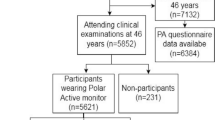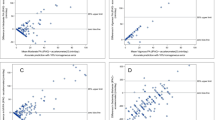Abstract
The purpose of this study is to investigate the construct validity of the Harvard Alumni Activity Survey (HAAS) in an urban, lower income population. Data were collected from 192 smokers enrolled in an antioxidant micronutrient trial. Activity data were compared to body mass index (BMI), diastolic, and systolic blood pressure. The traditional physical activity index (PAI), using data on stair climbing, walking, and sports, was calculated including and excluding body mass. A new scale, the total weekly activity (TWA) scale, was derived from other questions on the HAAS. The PAI scale calculated with body mass was unassociated with BMI and blood pressure. The PAI scale calculated without body mass was unassociated with BMI and systolic blood pressure but was associated with diastolic blood pressure (Beta = −0.001, p = 0.03). The TWA scale was associated with BMI (Beta = −0.01, p = 0.01), diastolic (Beta = −0.03, p = 0.01), and systolic blood pressure (Beta = −0.04, p = 0.01). A one standard deviation change in the TWA scale is predicted to be equivalent to a change of 0.99 BMI units, 2.97 mmHg of diastolic blood pressure, and 3.96 mmHg of systolic blood pressure. This work suggests that the TWA scale has greater construct validity than the traditional PAI scale in this population.
Similar content being viewed by others
Abbreviations
- BMI:
-
body mass index
- HAAS:
-
Harvard alumni activity survey
- PAI:
-
physical activity index
- TWA:
-
total weekly activity
References
Paffenbarger RS, Jr., Wing AL, Hyde RT. Physical activity as an index of heart attack risk in college alumni. Am J Epidemiol. 1978;108(3):161–175.
Paffenbarger RS, Jr., Hyde RT, Hsieh CC, Wing AL. Physical activity, other life-style patterns, cardiovascular disease and longevity. Acta Medica Scandinavica—Supplementum. 1986;711:85–91.
Irwin ML, Yasui Y, Ulrich CM, et al. Effect of exercise on total and intra-abdominal body fat in postmenopausal women: a randomized controlled trial. JAMA. 2003;289(3):323–330.
Helmrich SP, Ragland DR, Paffenbarger RS, Jr. Prevention of non-insulin-dependent diabetes mellitus with physical activity. Med Sci Sports Exerc. 1994;26(7):824–830.
Lee I, Paffenbarger R. Physical activity and its relation to cancer risk: a prospective study of college alumni. Med Sci Sports Exerc. 1994;26(7):831–837.
Pereira MA, FitzerGerald SJ, Gregg EW, et al. A collection of physical activity questionnaires for health-related research. Med Sci Sports Exerc. 1997;29(6 Suppl):S1–S205.
Jacobs DR, Jr., Ainsworth BE, Hartman TJ, Leon AS. A simultaneous evaluation of 10 commonly used physical activity questionnaires. Med Sci Sports Exerc. 1993;25(1):81–91.
Rauh MJ, Hovell MF, Hofstetter CR, Sallis JF, Gleghorn A. Reliability and validity of self-reported physical activity in Latinos. Int J Epidemiol. 1992;21(5):966–971.
Singh PN, Fraser GE, Knutsen SF, Lindsted KD, Bennett HW. Validity of a physical activity questionnaire among African-American Seventh-day Adventists. Med Sci Sports Exerc. 2001;33(3):468–475.
Ford ES, Merritt RK, Heath GW, et al. Physical activity behaviors in lower and higher socioeconomic status populations. Am J Epidemiol. 1991;133(12):1246–1256.
Salmon J, Owen N, Bauman A, Schmitz MK, Booth M. Leisure-time, occupational, and household physical activity among professional, skilled, and less-skilled workers and homemakers. Prev Med. 2000;30(3):191–199.
Cauley JA, Donfield SM, Laporte RE, Warhaftig NE. Physical activity by socioeconomic status in two population based cohorts. Med Sci Sports Exerc. 1991;23(3):343–351.
Mooney L, Madsen A, Tang D, et al. Antioxidant vitamin supplementation reduces benzo(a)pyrene-DNA adducts and potential cancer risk in female smokers. Cancer Epidemiol Biomarkers and Prev. 2005;14(1):237–242.
Ainsworth BE, Leon AS, Richardson MT, Jacobs DR, Paffenbarger RS, Jr. Accuracy of the college alumnus physical activity questionnaire. J Clin Epidemiol. 1993;46(12):1403–1411.
Washburn RA, Smith KW, Goldfield SR, McKinlay JB. Reliability and physiologic correlates of the Harvard Alumni Activity Survey in a general population. J Clin Epidemiol. 1991;44(12):1319–1326.
Siconolfi SF, Lasater TM, Snow RC, Carleton RA. Self-reported physical activity compared with maximal oxygen uptake. Am J Epidemiol. 1985;122(1):101–105.
Albanes D, Conway JM, Taylor PR, Moe PW, Judd J. Validation and comparison of eight physical activity questionnaires. Epidemiology. 1990;1(1):65–71.
Craig CL, Marshall AL, Sjostrom M, et al. International physical activity questionnaire: 12-country reliability and validity. Med Sci Sports Exerc. 2003;35(8):1381–1395.
Paffenbarger R, Blair S, Lee I, Hyde R. Measurement of physical activity to assess health effects in free-living populations. Med Sci Sports Exerc. 1993 1993;25(1):60–70.
Lee IM, Paffenbarger RS, Jr., Hsieh CC. Time trends in physical activity among college alumni, 1962–1988. Am J Epidemiol. 1992;135(8):915–925.
Ainsworth B, Haskell W, Whitt M, et al. Compendium of physical activities: an update of activity codes and MET intensities. Med Sci Sports Exerc. 2000;32(9 Suppl):S498–S504.
Flanders W, DerSimonian R, Freedman D. Interpretation of linear regression models that include transformations or interaction terms. Ann Epidemiol. 1992;2(5):735–744.
Fagard R. Physical fitness and blood pressure. J Hypertens. 1993;Suppl 5:S47–S52.
Lesniak K, Dubbert P. Exercise and hypertension. Curr Opin Cardiol. 2001;16(6):356–359.
Whelton S, Chin A, Xin X, He J. Effect of aerobic exercise on blood pressure: a meta-analysis of randomized, controlled trials. Ann Intern Med. 2002;136(7):493–503.
Owens J, Matthews K, Wing R, Kuller L. Physical activity and cardiovascular risk: a cross-sectional study of middle-aged premenopausal women. Prev Med. 1990;19(2):147–157.
Washburn RA, McAuley E, Katula J, Mihalko SL, Boileau RA. The physical activity scale for the elderly (PASE): evidence for validity. J Clin Epidemiol. 1999;52(7):643–651.
Bowles HR, FitzGerald SJ, Morrow JR, Jr., Jackson AW, Blair SN. Construct validity of self-reported historical physical activity. Am J Epidemiol. 2004;160(3):279–286.
Smith K, McKinlay S, McKinlay J. The reliability of health risk appraisals: a field trial of four instruments. Am J Public Health. 1989;79(12):1603–1607.
Young DR, Miller KW, Wilder LB, Yanek LR, Becker DM. Physical activity patterns of urban African Americans. J Community Health. 1998;23(2):99–112.
Centers for Disease Control. Physical Activity and Health: A Report of the Surgeon General. Atlanta, GA: US Department of Health and Human Services; 1996.
Centers for Disease Control. Prevalence of leisure-time and occupational physical activity among employed adults—United States, 1990. MMWR Morb Mortal Wkly Rep. 2000;49(19):420–424.
DeVellis R. Scale Development: Theory and Applications. Newbury Park, Ca: Sage; 1991.
Acknowledgements
This work was supported by grants from the National Institutes of Health (K07CA092348-01A1, M01RR000645-310825, and U54 CA101598-01) and The New York City Council Speaker’s Fund for Public Health Research. Dr. Rundle is a NCMHD Health Disparities Scholar.
Author information
Authors and Affiliations
Corresponding author
Additional information
Rundle is with the Department of Epidemiology, Mailman School of Public Health, Columbia University, New York, NY, USA; Hagins is with the Division of Physical Therapy, School of Health Professions, Long Island University, Brooklyn Campus, Brooklyn, NY, USA; Orjuela, Mooney, Kim, and Perera are with the Department of Environmental Health Sciences, Mailman School of Public Health, Columbia University, New York, NY, USA.
Rights and permissions
About this article
Cite this article
Rundle, A., Hagins, M., Orjuela, M. et al. Traditional Physical Activity Indexes Derived from the Harvard Alumni Activity Survey Have Low Construct Validity in a Lower Income, Urban Population. J Urban Health 84, 722–732 (2007). https://doi.org/10.1007/s11524-007-9212-4
Received:
Accepted:
Published:
Issue Date:
DOI: https://doi.org/10.1007/s11524-007-9212-4




